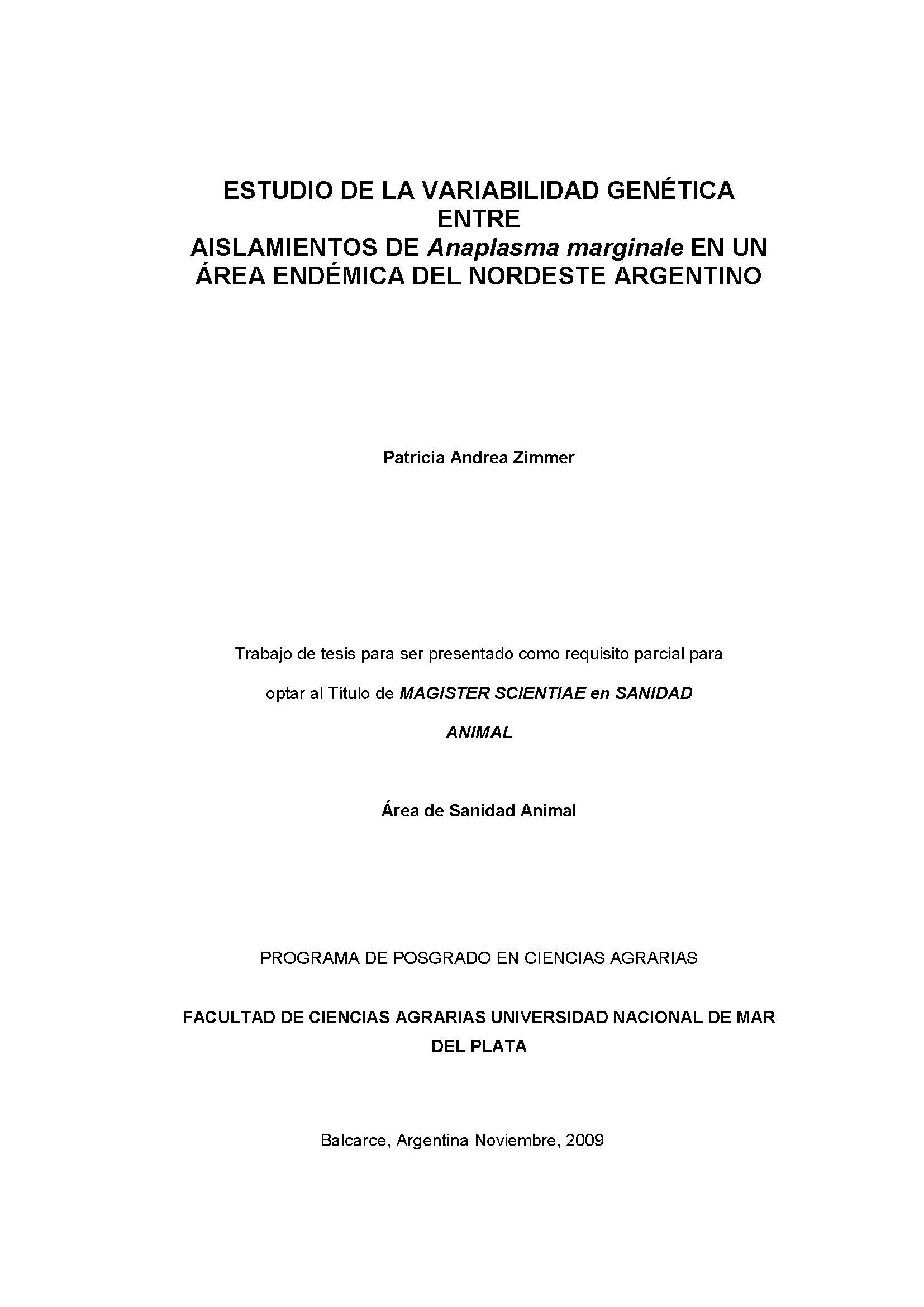View Item
- xmlui.general.dspace_homeCentros Regionales y EEAsCentro Regional CorrientesEEA MercedesTesisxmlui.ArtifactBrowser.ItemViewer.trail
Estudio de la variabilidad genética entre aislamientos de Anaplasma marginale en un área endémica del Nordeste Argentino
Abstract
El objetivo del presente trabajo fue conocer las variantes genotípicas de Anaplasma marginale, en rodeos bovinos en una región del noroeste de Entre Ríos con antecedentes de ocurrencia de casos clínicos de anaplasmosis. A partir de un estudio observacional se obtuvieron muestras (sangre y suero) de terneros de cuatro a ocho meses de edad, de 49 establecimientos de los departamentos de Feliciano, Federal y La Paz (n=989). Las muestras de sueros se
[ver mas...]
El objetivo del presente trabajo fue conocer las variantes genotípicas de Anaplasma marginale, en rodeos bovinos en una región del noroeste de Entre Ríos con antecedentes de ocurrencia de casos clínicos de anaplasmosis. A partir de un estudio observacional se obtuvieron muestras (sangre y suero) de terneros de cuatro a ocho meses de edad, de 49 establecimientos de los departamentos de Feliciano, Federal y La Paz (n=989). Las muestras de sueros se procesaron mediante la prueba de c-ELISA y según su resultado se determinó el estatus epidemiológico de anaplasmosis para cada rodeo (Mahoney; Ross, 1972). Mediante una selección de muestras por conveniencia se analizaron por PCR msp5 y RLBH 291 y 87 muestras de sangre respectivamente. Se evaluaron las variantes genotípicas del marcador molecular msp1α de A. marginale que presenta diferencias nucleotídicas en el número de repeticiones en tandem y en el tipo de bloque. Se determinó la variabilidad intra e inter-predio (OR). Se determinó que sólo 10 de los 49 rodeos analizados resultaron positivos a Anaplasma spp, y todos se encontraban en inestabilidad enzoótica, con alto o bajo riesgo de de ocurrencia de brotes de anaplasmosis. El 3,7
% (37/989), de los terneros resultó positivo en c-ELISA, mientras que de las muestras seleccionadas el 13,7 % (40/291) y el 39 % (34/87) fueron positivas en PCR msp5 y RLBH respectivamente. Las tres técnicas mostraron muy buena concordancia (K ≥ 0,8). Se encontraron ocho genotipos diferentes en los establecimientos de la Paz y Feliciano, de los cuales, cinco genotipos y dos bloques se describieron por primera vez en este trabajo. La variabilidad intra e inter establecimiento tuvo un Odds Ratio: 12,4 (IC 95% 5,9-25,67) y una asociación significativa (X2 46,3; p<0,0001), lo que indica que los genotipos que pertenecen al mismo establecimiento tienen mayor probabilidad de incluir secuencias iguales y la diversidad genotípica de los aislamientos no tendría una distribución al azar, sino por el contrario estaría agrupada por establecimientos. Las diferentes técnicas diagnósticas aplicadas estratégicamente, la recopilación de antecedentes y el conocimiento de la diversidad genotípica de A. marginale proporcionaron nueva información sobre la epidemiología de la anaplasmosis bovina en el NO de Entre Ríos.
[Cerrar]
The objective of this work was to study the genetic diversity of A. marginale in beef cattle herds in the North West of Entre Rios, province where clinical cases of anaplasmosis has frequently been reported. To establish the epidemiological status of each herd, samples from 49 cattle farms, located in 3 districts (n=989) were obtained and analyzed using c-ELISA. Convenient samples were selected to analyze blood samples using PCRmsp5 (n=291) and RLBH
[ver mas...]
The objective of this work was to study the genetic diversity of A. marginale in beef cattle herds in the North West of Entre Rios, province where clinical cases of anaplasmosis has frequently been reported. To establish the epidemiological status of each herd, samples from 49 cattle farms, located in 3 districts (n=989) were obtained and analyzed using c-ELISA. Convenient samples were selected to analyze blood samples using PCRmsp5 (n=291) and RLBH (n=87). The msp1α gene of A. marginale, selected as molecular marker, was analyzed based on nucleotide differences in the number of repetitions in tandem and in the block type. The genetic variability in and between herds was also evaluated (odds ratio).
Ten of 49 herds (20,4%) resulted positive to Anaplasma spp. and were under enzootic instability with either high or low risk of occurrence of anaplasmosis outbreaks; 3.7 % (37/989) of calves were positive to c-ELISA, meanwhile on the selected blood samples 13.7 % (40/291) and 39% (39/87) were positives to PCRmsp5 and RLBH respectively. The three techniques showed a high concord (K≥ 0.8). Eight different genotypes were identified in La Paz and Feliciano districts, five of the genotypes and two of the blocks were described for the first time in Argentina. The odds ratio in and between herds was
12.4 (IC 95% 5.999-25.67) with significant association (X2 46.3; p <0.0001), pointing out that genotypes identified in each herd, had higher probabilities to include identical sequences. The A. marginale genetic diversity would not be randomly distributed; on the contrary it would be restricted to each herd. The conclusion of this work is that the combination of different diagnostic techniques and the knowledge of A. marginale genetic diversity provided solid information on the epidemiology of the bovine anaplasmosis in the NW of Entre Rios, and allowed to establish the needed to implement preventive measures in this region.
[Cerrar]

Author
Director de Tesis
Descripción
Tesis para obtener el grado de Magíster Scientiae en Sanidad Animal, de la Universidad Nacional de Mar del Plata, en noviembre de 2009
Date
2009-11
Editorial
Facultad de Ciencias Agrarias, Universidad Nacional de Mar del Plata
Formato
pdf
Tipo de documento
tesis de maestría
Palabras Claves
Derechos de acceso
Abierto
 Excepto donde se diga explicitamente, este item se publica bajo la siguiente descripción: Creative Commons Attribution-NonCommercial-ShareAlike 2.5 Unported (CC BY-NC-SA 2.5)
Excepto donde se diga explicitamente, este item se publica bajo la siguiente descripción: Creative Commons Attribution-NonCommercial-ShareAlike 2.5 Unported (CC BY-NC-SA 2.5)


